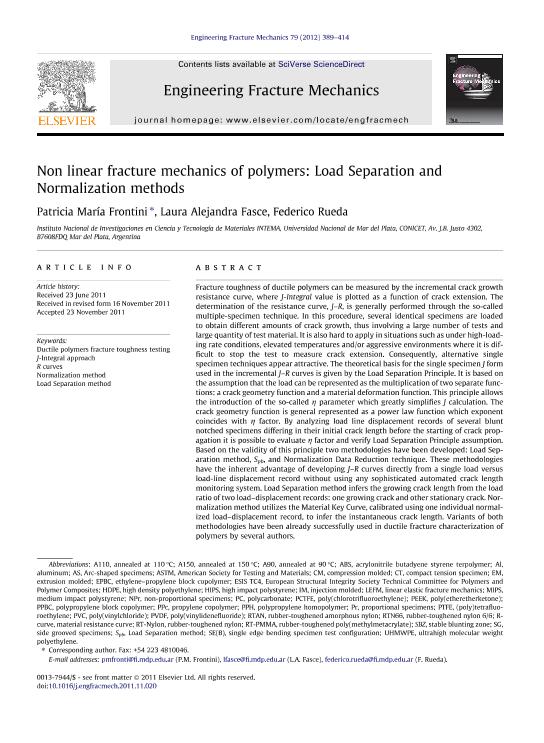Mostrar el registro sencillo del ítem
dc.contributor.author
Frontini, Patricia Maria

dc.contributor.author
Fasce, Laura Alejandra

dc.contributor.author
Rueda, Federico

dc.date.available
2018-08-16T19:03:54Z
dc.date.issued
2012-01
dc.identifier.citation
Frontini, Patricia Maria; Fasce, Laura Alejandra; Rueda, Federico; Non linear fracture mechanics of polymers: Load Separation and Normalization methods; Pergamon-Elsevier Science Ltd; Engineering Fracture Mechanics; 79; 1-2012; 389-414
dc.identifier.issn
0013-7944
dc.identifier.uri
http://hdl.handle.net/11336/55986
dc.description.abstract
Fracture toughness of ductile polymers can be measured by the incremental crack growth resistance curve, where J-Integral value is plotted as a function of crack extension. The determination of the resistance curve, J-R, is generally performed through the so-called multiple-specimen technique. In this procedure, several identical specimens are loaded to obtain different amounts of crack growth, thus involving a large number of tests and large quantity of test material. It is also hard to apply in situations such as under high-loading rate conditions, elevated temperatures and/or aggressive environments where it is difficult to stop the test to measure crack extension. Consequently, alternative single specimen techniques appear attractive. The theoretical basis for the single specimen J form used in the incremental J-R curves is given by the Load Separation Principle. It is based on the assumption that the load can be represented as the multiplication of two separate functions: a crack geometry function and a material deformation function. This principle allows the introduction of the so-called η parameter which greatly simplifies J calculation. The crack geometry function is general represented as a power law function which exponent coincides with η factor. By analyzing load line displacement records of several blunt notched specimens differing in their initial crack length before the starting of crack propagation it is possible to evaluate η factor and verify Load Separation Principle assumption. Based on the validity of this principle two methodologies have been developed: Load Separation method, S pb, and Normalization Data Reduction technique. These methodologies have the inherent advantage of developing J-R curves directly from a single load versus load-line displacement record without using any sophisticated automated crack length monitoring system. Load Separation method infers the growing crack length from the load ratio of two load-displacement records: one growing crack and other stationary crack. Normalization method utilizes the Material Key Curve, calibrated using one individual normalized load-displacement record, to infer the instantaneous crack length. Variants of both methodologies have been already successfully used in ductile fracture characterization of polymers by several authors.Innovatively here, the Load Separation Principle and the deformation function are expressed in terms of total displacement without distinguishing between elastic and plastic displacement components. Hence, calculations are simply made using the J-Integral formula based on total energy. The performance of the proposed methods is evaluated and compared with the standard multiple-specimen technique for a broad spectrum of ductile polymers. Several features of the approaches are discussed like: suitability of functional forms, influence of blunting assumption, calibration points and general limitations to their application. The results demonstrate the ease and the accurate of the Normalization method based on total displacement for ductile polymer J-R curve determination. Conversely, the great potentiality of Load Separation method relies on the special fracture cases in which the actual final crack length cannot be easily determined. © 2011 Elsevier Ltd.
dc.format
application/pdf
dc.language.iso
eng
dc.publisher
Pergamon-Elsevier Science Ltd

dc.rights
info:eu-repo/semantics/openAccess
dc.rights.uri
https://creativecommons.org/licenses/by-nc-sa/2.5/ar/
dc.subject
Ductile Polymers Fracture Toughness Testing
dc.subject
J-Integral Approach
dc.subject
Load Separation Method
dc.subject
Normalization Method
dc.subject
R Curves
dc.subject.classification
Ingeniería de los Materiales

dc.subject.classification
Ingeniería de los Materiales

dc.subject.classification
INGENIERÍAS Y TECNOLOGÍAS

dc.subject.classification
Otras Ingeniería Mecánica

dc.subject.classification
Ingeniería Mecánica

dc.subject.classification
INGENIERÍAS Y TECNOLOGÍAS

dc.title
Non linear fracture mechanics of polymers: Load Separation and Normalization methods
dc.type
info:eu-repo/semantics/article
dc.type
info:ar-repo/semantics/artículo
dc.type
info:eu-repo/semantics/publishedVersion
dc.date.updated
2018-08-13T17:22:02Z
dc.journal.volume
79
dc.journal.pagination
389-414
dc.journal.pais
Estados Unidos

dc.journal.ciudad
Atlanta
dc.description.fil
Fil: Frontini, Patricia Maria. Consejo Nacional de Investigaciones Científicas y Técnicas. Centro Científico Tecnológico Conicet - Mar del Plata. Instituto de Investigaciones en Ciencia y Tecnología de Materiales. Universidad Nacional de Mar del Plata. Facultad de Ingeniería. Instituto de Investigaciones en Ciencia y Tecnología de Materiales; Argentina
dc.description.fil
Fil: Fasce, Laura Alejandra. Consejo Nacional de Investigaciones Científicas y Técnicas. Centro Científico Tecnológico Conicet - Mar del Plata. Instituto de Investigaciones en Ciencia y Tecnología de Materiales. Universidad Nacional de Mar del Plata. Facultad de Ingeniería. Instituto de Investigaciones en Ciencia y Tecnología de Materiales; Argentina
dc.description.fil
Fil: Rueda, Federico. Consejo Nacional de Investigaciones Científicas y Técnicas. Centro Científico Tecnológico Conicet - Mar del Plata. Instituto de Investigaciones en Ciencia y Tecnología de Materiales. Universidad Nacional de Mar del Plata. Facultad de Ingeniería. Instituto de Investigaciones en Ciencia y Tecnología de Materiales; Argentina
dc.journal.title
Engineering Fracture Mechanics

dc.relation.alternativeid
info:eu-repo/semantics/altIdentifier/doi/https://dx.doi.org/10.1016/j.engfracmech.2011.11.020
dc.relation.alternativeid
info:eu-repo/semantics/altIdentifier/url/https://www.sciencedirect.com/science/article/pii/S0013794411004280
Archivos asociados
